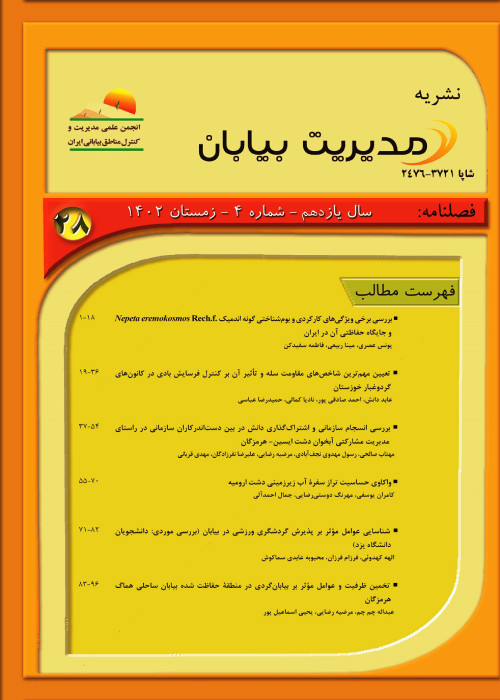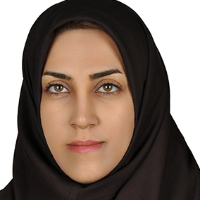Study of The Relation Between the Status of The Isin Bandar Abbas Plain Aquifer and Land Use Changes
Author(s):
Article Type:
Research/Original Article (دارای رتبه معتبر)
Abstract:
IntroductionGroundwater is among the most precious natural resources for human health, economic development and environmental diversity. Since the measurement of groundwater parameters and water quality is difficult, costly and far from being available, interpolation techniques are an easy solution. At the same time, there is a strong correlation between groundwater quality and land use in areas with sensitive aquifers. Changes in land use caused by factors such as rapid growth and expansion of urban centers, rapid population growth, and the lack of land, the need for increased production and the evolution of technologies are important concerns. The literature review shows that the quantitative and qualitative decline in groundwater is a global crisis. As a result, the factors affecting the quantitative and qualitative decline in groundwater range from climate factors to socio-economic factors.In the current research, find an answer to the poor condition of the Isin Plain aquifer by looking at the relationship between some hydrological factors and changes in cultivation pattern of the region is the main goal. For this purpose, the water table and EC of groundwater were interpolated using geostatistical methods. Using satellite imagery, the trend of culture pattern changes over time was obtained. Finally, the relation between the factors on the Isin plain was established. Material and MethodsFor this purpose, the quantity and quality of groundwater in eastern and western Isin plains were interpolated using the Kriging and IDW methods, during the four statistical years of 2004, 2011, 2018, and 2021 and the time series of 2004-2021. The RMSE statistic was used to evaluate the performance of the methods.Then, satellite images and ground truth data was used for land use change classes to investigate the land use changes during the cropping season, along with the determination of changes in the quantity and quality of groundwater in the eastern and western Isin plains for the mentioned years. Satellite data including Landsat 5 multi-temporal satellite images in 2004, 2011, and 2018 and Landsat 8 and Sentinel 2 images for February 2021 were obtained from the USGS.Following preparation of the related images using the flash module, atmospheric and radiometric corrections were performed. Then, the corrections information was extracted into the text file appended to each image. With field survey, the coordinates of the representative pixels were determined and seven land use classes of gardens, vegetables, bare lands, residential and industrial areas, saline lands, and Prosopis Cineraria and Juliflora species were determined. The maximum likelihood classification method was used to separate seven main land use classes based on 127 training samples. For the purpose of assessing accuracy, an error matrix was created for the producer's accuracy, the user's accuracy, the overall accuracy, and the kappa coefficient calculation. Finally, to examine the relationship, the land use map and the groundwater and EC interpolation maps were overlapped into the Arc Map software environment. Results and DiscussionBy comparing the interpolation methods of IDW and Kriging with the RMSE validation technique, it was found that the best interpolation method for estimating water table and EC is Kriging, followed by the IDW method. A review of the land use maps of the Eastern and Western Plains of Isin showed the increase and decrease of different land use categories over the years under study. The overall accuracy and Kappa coefficient were over 82% and 0.79, indicating the acceptable accuracy of the classification and maps obtained. The results of overlapping land use maps and spatial changes in ground water indicate that the location of agricultural land, especially gardens in the eastern Isin plain and vegetables in the western Isin plain, is compatible with the areas of having low water table. The results of overlapping the land use map obtained from Landsat 8 data and EC spatial changes showed the highest amount of EC in can be observed in Prosopis Cineraria and Juliflora species and residential and industrial uses in eastern and western Isin plain. The results obtained from Sentinel2 indicate that the value of EC was significant in the bare lands of eastern Isin and in the saline lands of western Isin. However, the increase in agricultural use, especially for gardens and vegetables, and the pairing with areas with the lowest water table indicates an over-extraction of groundwater for agricultural purposes. On the other hand, the significant extent of bare lands and the upward trend of saline lands, residential and industrial areas, and matching with areas with high EC and the adaptation of maximum EC with Prosopis Cineraria and Juliflora species uses may be a warning for poor condition of the Isin plain aquifer.
Keywords:
Language:
Persian
Published:
Desert Management, Volume:11 Issue: 25, 2023
Pages:
95 to 116
magiran.com/p2597926
دانلود و مطالعه متن این مقاله با یکی از روشهای زیر امکان پذیر است:
اشتراک شخصی
با عضویت و پرداخت آنلاین حق اشتراک یکساله به مبلغ 1,390,000ريال میتوانید 70 عنوان مطلب دانلود کنید!
اشتراک سازمانی
به کتابخانه دانشگاه یا محل کار خود پیشنهاد کنید تا اشتراک سازمانی این پایگاه را برای دسترسی نامحدود همه کاربران به متن مطالب تهیه نمایند!
توجه!
- حق عضویت دریافتی صرف حمایت از نشریات عضو و نگهداری، تکمیل و توسعه مگیران میشود.
- پرداخت حق اشتراک و دانلود مقالات اجازه بازنشر آن در سایر رسانههای چاپی و دیجیتال را به کاربر نمیدهد.
In order to view content subscription is required
Personal subscription
Subscribe magiran.com for 70 € euros via PayPal and download 70 articles during a year.
Organization subscription
Please contact us to subscribe your university or library for unlimited access!




